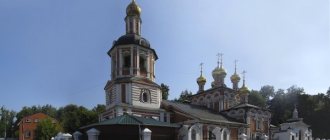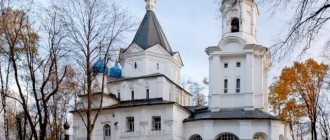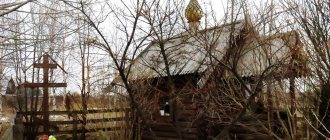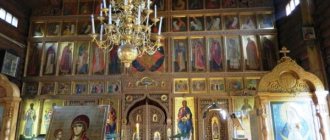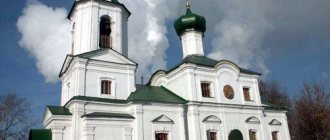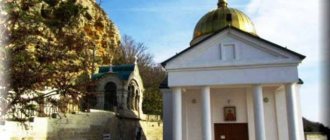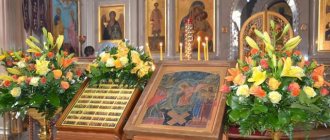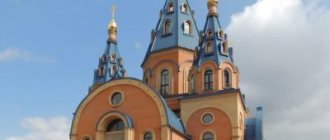Mir
Church of the Nativity (Mytishchi) Map is loading...
{"format":"leaflet","minzoom":false,"maxzoom":false,"limit":50,"offset":0,"link":"all","sort":[""], "order":[],"headers":"show","mainlabel":"","intro":"","outro":"","searchlabel":"\u2026 \u0441\u043b\u0435\ u0434\u0443\u044e\u0449\u0438\u0435 \u0440\u0435\u0437\u0443\u043b\u044c\u0442\u0430\u0442\u044b","default":"","import-annotation":false,"width ":"auto","height":"350px","centre":{"text":"","title":"""link":"""lat":55.91678499999999729652699897997081279754638671875,"lon": 37.7482710000000025729605113156139850616455078125,"icon":""},"title":"","label":"","icon":"","lines":[],"polygons":[],"circles":[ ],"rectangles":[],"copycoords":false,"static":false,"zoom":8,"defzoom":14,"layers":["OpenStreetMap"],"image layers":[] ,"overlays":[],"resizable":false,"fullscreen":true,"scrollwheelzoom":true,"cluster":false,"clustermaxzoom":9,"clusterzoomonclick":true,"clustermaxradius":80, "clusterspiderfy":true,"geojson":"","clicktarget":"","showtitle":true,"hidenamespace":false,"template":"","userparam":"","activeicon": "","pagelabel":false,"ajaxcoordproperty":"","ajaxquery":"","locations":[{"text":"\u003Cb\u003E\u003Ca href=\"/palomnik/%D0% A5%D1%80%D0%B8%D1%81%D1%82%D0%BE%D1%80%D0%BE%D0%B6%D0%B4%D0%B5%D1%81%D1%82% D0%B2%D0%B5%D0%BD%D1%81%D0%BA%D0%B8%D0%B9_%D1%85%D1%80%D0%B0%D0%BC_(%D0%9C%D1 %8B%D1%82%D0%B8%D1%89%D0%B8)\» title=\»\u0425\u0440\u0438\u0441\u0442\u043e\u0440\u043e\u0436\u0434\u0435\u0441\ u0442\u0432\u0435\u043d\u0441\u043a\u0438\u0439 \u0445\u0440\u0430\u043c (\u041c\u044b\u0442\u0438\u0449\u0438)\»\u003E\u0425 \u0440\u0438\u0441\ u0442\u043e\u0440\u043e\u0436\u0434\u0435\u0441\u0442\u0432\u0435\u043d\u0441\u043a\u0438\u0439 \u0445\u0440\u0430\u043c (\u0 41c\u044b\u0442\u0438\u0449 \u0438)\u003C/a\u003E\u003C/b\u003E\u003Chr /\u003E\u003Ca href=\»/palomnik/%D0%A1%D0%B2%D0%BE%D0%B9%D1%81% D1%82%D0%B2%D0%BE:%D0%90%D0%BD%D0%BD%D0%BE%D1%82%D0%B0%D1%86%D0%B8%D1%8F\" title=\»\u0421\u0432\u043e\u0439\u0441\u0442\u0432\u043e:\u0410\u043d\u043d\u043e\u0442\u0430\u0446\u0438\u044f\»\u003E\u0410\u0 43d\u043d\ u043e\u0442\u0430\u0446\u0438\u044f\u003C/a\u003E: »'\u0425\u0440\u0438\u0441\u0442\u043e\u0440\u043e\u0436\u0434\u0435\u044 1\u0442\u0432\u0435 '' 33\u043e\u0434\u0443\u043d\ u0430 \u043f\u043e\u0436\u0435\u0440\u0442\u0432\u043e\u0432\u0430\u043d\u0438\u044f \u043c\u0435\u0441\u0442\u043d\u044b\u0 445\u0436\u0438\u0442\u0435\ u043b\u0435\u0439 \u0438 \u043c\u0435\u0446\u0435\u043d\u0430\u0442\u043e\u0432, \u043f\u043e \u043f\u0440\u043e\u0435\u043a \u0442\u0443 \u0430\u0440\u0445 \u0438\u0442\u0435\u043a\u0442\u043e\u0440\u043e\u0432 \u041f\u0430\u043d\u043a\u0440\u0430\u0442\u043e\u0432\u0430 \u041c. \u0410., \u0420\u0430\ u0445\u043c\u0430\u043d\u043e\u0432\u0430 \u041d.\u0424.","title":"\u0425\u0440\u0438\u0441\u0442\u043e\u0440\u043e\u0436\u0434\u 0435\u0441 """lat" :55.91678499999999729652699897997081279754638671875,"lon":37.7482710000000025729605113156139850616455078125,"icon":""}],"imageLayers": []}
Address:
Moscow region, Mytishchi district, Mytishchi, Novomytishchi Ave., 6. Church of the Nativity.
Telephone:
+7 (495)583-75-52
Email:
Church of the Nativity
built in 2003 with donations from local residents and patrons, according to the design of architects M.A. Pankratov, N.F. Rakhmanov.
Church of the Nativity today
The Church of the Nativity in Mytishchi is located in the city center at the intersection of busy transport arteries. It became the first religious building to appear in the city after the 70-year period of Bolshevik rule.
The grandiose white-stone cathedral has become the center of the spiritual life of the residents of Mytishchi and one of the points of excursion trips to the iconic architectural monuments of the Moscow region.
Sponsorship
Many people and organizations took part in the implementation of the idea of building the temple. Government officials took an active part during construction. B.V. Gromov, the governor of the Moscow region, showed great interest in the results of construction. He constantly visited the temple during its construction and later, when the cathedral was already built. The main stages of construction were carried out by S.A. Butusova, whose director is S.A. Butusova, and LaVina, its director is A.A. Yazykov. Head of the city administration A.E. Murashov organized a collection of donations for this charitable cause; funds were collected in almost all organizations and enterprises of the city.
The result of the work of many people was one of the largest and most beautiful religious buildings in the Moscow region - the Church of the Nativity of Christ. Photos of this temple allow you to appreciate the majesty and splendor of the erected cathedral.
History of construction
By the beginning of the 21st century, 3 Orthodox churches functioned in the Mytishchi district, which could not accommodate all the people who wanted to turn to the Lord. All of them were located in suburban villages, which made them difficult for residents of central city neighborhoods to visit. In this regard, the need to build a religious building in the center of the settlement became obvious.
In 2000, on the occasion of the Nativity of Christ, Metropolitan Yuvenaly blessed the initiative of the townspeople to build a new church. The city authorities also supported this good initiative.
Foundation stone of the Church of the Nativity in Mytishchi
From this moment the preparatory period of construction began, consisting of the following:
- organizing fundraising for construction work;
- preparation of an architectural design for the future temple;
- selection and approval of a suitable land plot.
Preparatory activities were completed by the summer of the same year. In July, the head of the Kolomna and Krutitsa diocese, Metropolitan Yuvenaly, performed the rite of consecration of the foundation stone.
City authorities, local entrepreneurs, and ordinary townspeople participated in the construction of a small wooden church.
Construction and finishing work was completed after 5 months. The first service took place on December 5, on the feast of the Entry into the Temple of the Blessed Virgin Mary, in honor of which the erected building was consecrated.
Already during the first service, the religious building could not accommodate all the parishioners. During the year, preparations were made for the construction of another larger building. In November 2001, work began on preparing the site and pouring the foundation for the temple.
These works were carried out as charity by two local construction organizations. Specialists from the company “Project” LLC worked on the architectural project under the leadership of N.F. Rakhmanov.
Funds for construction work came from the following sources:
- municipal budget;
- donations from municipal and private enterprises in the area;
- all possible assistance from parishioners participating in the “Name Brick” campaign.
The construction work was observed by the head of the Moscow region B.V. Gromov. The first divine service took place on the day of the Holy Resurrection of Christ in 2004. A year later, the Moscow region governor was present at the Easter service in the already completed building. He noted the enormous work of builders and parishioners in improving the area adjacent to the temple.
The ceremonial consecration of the temple took place on July 10, 2005. It was conducted by Metropolitan Yuvenaly in the presence of the heads of the city and regional administration. Activities to improve the temple space and the surrounding area continued for several years.
History[edit]
The small settlement of Mytishchi became a city already in the 20s of the twentieth century, when it was not possible to build a temple. A large residential area found itself without spiritual nourishment. After the transformations in our country, the need to build a temple was obvious. This good deed was entrusted to the cleric of the Church of the Vladimir Mother of God, priest Oleg Shlenov. Joint work with the city administration began. It took a long time to choose the site for the temple. On April 27, 2000, by decree of the head of the Mytishchi administration A.E. Murashov, a site was allocated in the very center of the city, perhaps the best possible.
On the anniversary of the 2000th anniversary of the Nativity of Christ, the plan of ceremonial events in the Mytishchi deanery dedicated to this event included the laying of the foundation of the future church, which was performed on July 6, 2000 by Metropolitan Juvenaly of Krutitsky and Kolomna in front of a large crowd of people. In his speech, the Metropolitan then called on everyone to take part in this saving and important work, expressing confidence that the erected temple would become the face and worthy adornment of the city.
Already now we can say with confidence that the words of Vladyka Juvenaly have been fulfilled literally and the Church of the Nativity of Christ in the city of Mytishchi is one of the most majestic and beautiful among other churches in the region.
After this event, work immediately began on the construction of a wooden temple for worship and the development of a project for a large stone temple. On December 4, 2000, the first Divine Liturgy was celebrated in the church in honor of the Entry into the Temple of the Most Holy Theotokos. In the fall of 2001, after the creation of the project and receipt of all approvals, construction work began, and in 2003, an action was held at the construction site in which city residents took part. For a voluntary donation, people had the opportunity to lay bricks into the walls of the temple with their own hands. One of the first to take part in this action was the governor of the Moscow region B.V. Gromov, the head of the Mytishchi district A.E. Murashov, the district administration, city organizations and everyone interested.
The Church of the Nativity of Christ, which united in the work of its creation not only all Mytishchi enterprises and organizations, but also ordinary residents of our city, under the leadership and personal control of the head of the Mytishchi district A.E. Murashov, was declared a “People's Construction Site”. And now the long-awaited day has come. On a sunny early morning, a joyful peal of bells announced to numerous parishioners the arrival of His Eminence the Archpastor. Vladyka Yuvenaly was met by the dean of the Mytishchi church district, priest Dimitry Olovyannikov, the rector of the Nativity Church, Archpriest Oleg Shlenov, and the head of the Mytishchi district, A.E. Murashov.
After the meeting and vestments, the great consecration of the temple began, which, in addition to the central altar, has two more chapels - in honor of the blessed Matrona of Moscow and the New Martyrs and Confessors of Russia. Concelebrating with His Eminence were Archbishop Gregory of Mozhaisk, Bishop Tikhon of Vidnovsky, Bishop Alexander of Dmitrov, and Bishop Georgy of Nizhny Novgorod and Arzamas.
Probably all those praying at the service sank into the hearts of the words of one of the prayers for the consecration of the temple, in which, in an address to the Lord, he asks: “-and establish it unshakably until the end of the age, and glorified in You, and grant us in it praise and praise without shame to bring Your glory - “And the first such doxologies and praise were offered on the same day: His Eminence Juvenal, after the consecration of the temple, celebrated the first Divine Liturgy in it.
After the consecration of the temple, work on its improvement does not stop. A fence was built around the temple, a magnificent carved iconostasis was made in the baptismal church in honor of St. John the Baptist, which was consecrated by Archbishop Gregory on March 18, 2007.
Architect, exterior decoration, architectural ensemble
The Church of the Nativity of Christ in Mytishchi is the center of the architectural complex, which in addition to it includes a wooden church and a Sunday school building.
Temple of the Entry into the Temple of the Blessed Virgin Mary
The first religious building, built on a vacant lot in the center of Mytishchi, is a temple consecrated in the name of the feast of the Entry into the Temple of the Blessed Virgin Mary. The small wooden church belongs to the oldest cage type of temple.
It consists of a central cage covered with a gable roof, above the center of which rises a quadrangle with a drum topped with an onion-shaped head. In the eastern rectangular porch there is an altar. In an identical structure, adjacent to the central part on the western side, there is a vestibule overlooking the open porch.
Don’t miss the most popular article in the section: Optina Pustyn Monastery - how to get there from Moscow, address, where it is located, history and interesting facts.
Church of the Nativity of Christ
The stone church, built according to the design of the architect N.F. Rakhmanov, is a cross-domed five-domed temple, with a high basement, an open walkway and spacious mezzanines. It is a stepped structure, gradually growing and tapering towards the center. The walls and vaults of the building are made of red brick and covered with white facade plaster.
The central part of the temple is an octagon with alternating wide and narrow edges. At its center is a wide light drum topped with a bulbous head. Four identical smaller drums are located above the narrow edges of the base.
The wide facades of the main part are adjacent to rectangular extensions, covered with semicircular vaults, which contain the apse and vestibules. Triple arched window portals are cut into the upper parts of the eastern, southern and northern extensions.
There is an open belfry above the western porch. The arched niches on the western facade are decorated with mosaic paintings depicting the Face of the Savior, the Virgin Mary and one of the Archangels.
A wide open walkway encircles the entire perimeter of the temple. High double-sided porches descend from it. The entrance to the ground floor is located under the western porch. To provide natural light, there is a row of low arched windows that encircle the entire basement.
History of the temple
The first documentary mention of the Temple of the Vladimir Icon of the Mother of God dates back to 1713. Then, in the village of Mytishchi, priest Dmitry consecrated the Church of the Wonderworker Nicholas. This year is conventionally considered the time of construction of the church.
The next written mention was in 1735. At this time, the church was already called the Temple of the Vladimir Icon of the Mother of God. A document dating back to 1735 speaks of a petition from Ivan Fedorov and the elder Trofimov for permission to replace the wooden floor in the church with a new stone one. The request was granted. In parallel with the replacement of gender, the restructuring of the thrones was carried out.
In 1814, due to the destruction of time, a decision was made to replace the wooden buildings with the refectory and bell tower. Two years later, the rector of the parish, Dmitry Fedorov, makes a request to the archbishop of the diocese to build the dismantled premises. The new refectory and bell tower of the church were built in 1819.
The temple gradually expanded. In 1832, a chapel was added to the church on the north side, named in honor of St. Nicholas. In 1898, the construction of the border of St. Sergei of Radonezh began, following the project of Schnaubert.
Near the temple there was a cemetery for the burial of Orthodox parishioners. It was here that the nurse of Alexander 2, the Russian Emperor, Avdotya Kartseva, found her last refuge. The burials have been destroyed by time. Today, the cemetery of the Church of the Vladimir Icon in Mytishchi is completely lost.
In 1804, the first water sewerage system was built in the vicinity of Moscow. From that time on, every year at the beginning of August there was a religious procession from the Temple of the Vladimir Icon of the Mother of God in the direction of the Holy (Gromovsky) spring. Near the chapel, now completely destroyed, a liturgy and blessing of water were held.
At the beginning of 1906, the temple of the Perlovsky village was annexed to the church, which is why the staff was increased (before that the shrine was considered one-person). Since 1912, Father Nikolai became the rector, who was inspired by the idea of building a parochial school. Fundraising has begun. In 1914, the institution, built according to Poezdeev’s architectural design, opened its doors to the people. Father Nikolai taught at the school of God's Law for children. Conversations on missionary topics and meetings of the temperance society were also held within its walls.
In 1929, the initiation of the closure of the temple began. A huge number of parishioners gathered outside the church to protest. People dispersed only after receiving promises that the parish would not be closed. At the same time, the abbots of the temple, Sergei Ilyinsky and Sergei Levshina, were exiled to a camp on Solovki.
Conversations around the closure of the church took place again in 1930. It was not possible to completely stop the work of the monastery, but the shrine succumbed to desecration. The largest bell was removed, the chapel was demolished, and part of the structure was taken over by storage facilities. In 1935, the church building was handed over to the Renovationists.
In 1941, part of the bell tower was demolished for military reasons (there were fears that it could become a landmark during the bombing of a plant in the vicinity of Podlipki). The following year the temple ceases its work. The building is used for the repair of fire service vehicles, and then as a supply base.
The shrine was completely rebuilt, losing its outer church façade. Only a small part of the protruding apse and the figure of eight above the elevation of the temple indicated that there had once been an abode of God here.
During the Soviet era, the church served as a warehouse. The return of the temple to believers took place in 1991. The church was headed by Abbot Alexander, who is currently serving as Bishop of Dmitrievsky. The same priest in 1994 became the head of the Mytishchi deanery.
The first service after a long period of closure took place in May 1991. In the same year, restoration work began to restore the appearance and interior decoration of the Church of the Vladimir Icon of the Mother of God, completed in 1995.
In 1999 (timed to coincide with the 2000th anniversary of the Nativity of Christ), construction of a new bell tower began. Work on it lasted about a year. The main goal was to create an exact copy using drawings from the time. The dome was raised and consecrated on November 5, 1999.
Today, the bell tower is dominated by a silver dome, as well as a spire and a cross. The current rector of the temple is Archpriest Dmitry Olovyannikov. On the territory of the church there is a children's Sunday school, teaching everyone about the Law of God.
Interior decoration
The Church of the Nativity of Christ in Mytishchi has two floors. On the ground floor there are administrative and utility rooms, as well as the lower baptismal church, consecrated in the name of the Forerunner and Baptist of the Lord John. Its main decoration is a two-tier carved iconostasis, most of the details of which are decorated with gilding.
The top floor consists of two tiers. In the upper part there are spacious choirs, fenced with carved wooden railings. All the walls and vaults of the prayer hall are covered with paintings depicting biblical scenes, the faces of holy primates and floral ornaments separating individual scenes. In addition to paintings, the walls are decorated with icons placed in carved frames.
There are three chapels in the upper church:
- in honor of the Nativity of Christ (main);
- in honor of the Council of New Martyrs and Confessors of Russia (southern);
- in the name of the Blessed Matrona of Moscow (northern).
In 2015, a Sunday school building was built next to the Church of the Nativity.
LiveInternetLiveInternet
Quote from Maya_Peshkova's message
Read in full In your quotation book or community!
Nativity churches in Moscow
Nativity. Painting of the Cathedral of Christ the Savior
There are not many churches dedicated to the Nativity of Christ in Moscow, but among them is the main temple of Moscow and all of Russia - the Cathedral of Christ the Savior. Its main chapel is consecrated in the name of the Nativity of Christ.
Today the Virgin gives birth to the Most Essential, And the Earth brings a den to the Unapproachable, Angels and shepherds glorify, The Vols travel with the Star, For for our sake the Child was born as a young child, the Eternal God
Roman Sladkopevets. Kontakion of the Nativity of Christ
The Cathedral of Christ the Savior - the main altar of the temple on the second floor - in the name of the Nativity of Christ.
Newborn Christ. Fragment of the altar painting of the Cathedral of Christ the Savior in Moscow
The Cathedral Cathedral of Christ the Savior in Moscow is the cathedral of the Russian Orthodox Church (Volkhonka Street, 15-17). The existing structure, built in the 1990s, is an external recreation of the temple of the same name, created in the 19th century.
Fragment of bronze sculptures on the pediment of the Cathedral of Christ the Savior.
The temple is a collective cenotaph of the soldiers of the Russian Imperial Army who died in the war with Napoleon; the names of officers who died in the Patriotic War of 1812 and the Foreign Campaigns of 1797-1806 and 1814-1815 are inscribed on the walls of the temple.
The original temple was erected in memory of the Napoleonic invasion according to the design of the architect K. A. Ton. Construction lasted almost 44 years: the temple was founded on September 23, 1839, consecrated on May 26, 1883. The temple building was destroyed at the height of Stalin's reconstruction of the city on December 5, 1931. Rebuilt in 1994-1997.
The temple has the status of the Patriarchal Metochion.
The temple, the largest in Russia at the time of completion, is designed for 10,000 people. In plan, the temple looks like an equilateral cross about 80 m wide. The height of the temple with the dome and cross is 103 m (1.5 m higher than St. Isaac's Cathedral)[1]. Built in the traditions of the Russian-Byzantine style, which enjoyed broad government support at the time construction began. The painting inside the temple occupies about 22,000 m2.
Fragment of the gate to the Temple. Cathedral of Christ the Savior. The design of the temple belongs to the architect Konstantin Tona. The construction of the Temple took about 44 years.
The modern complex of the Cathedral of Christ the Savior includes:
The upper temple is the Cathedral of Christ the Savior itself. It has three altars: the main one in honor of the Nativity of Christ and two side altars in the choir in the name of St. Nicholas the Wonderworker (south) and Saint Prince Alexander Nevsky (north). Consecrated on August 6 (19), 2000;
Nativity. Altar painting of the Cathedral of Christ the Savior
Lower Temple — Transfiguration Church, built in memory of the Alekseevsky women’s monastery located on this site. It has three altars: the main one in honor of the Transfiguration of the Lord and two small chapels in honor of Alexy the Man of God and the Tikhvin Icon of the Mother of God. The church was consecrated on August 6 (19), 1996.
"Christmas festive service in the Cathedral of Christ the Savior." Parishioners and priests at the night festive service in honor of the Nativity of Christ in the Cathedral of Christ the Savior.
Adoration of the Magi. Painting of the Cathedral of Christ the Savior
Temple of the Sovereign Icon of the Mother of God, Moscow. Complex of the Cathedral of Christ the Savior The stylobate part, which houses the temple museum, the hall of Church Councils, the hall of the Supreme Church Council, refectory chambers, as well as technical and service premises.
Fragments of the destroyed Cathedral of Christ the Savior, stored in the cemetery of the Donskoy Monastery
The Church of the Nativity in Izmailovo is an Orthodox church of the Nativity deanery of the Moscow diocese, an architectural monument.
Bell tower from the early 18th century, western façade
The temple is located in the Izmailovo district of the Eastern Administrative District of Moscow, named after the Nativity of Christ - one of the main Christian holidays. The church was consecrated in 1676 by Patriarch Joachim and was (along with the Church of the Intercession and the now destroyed Church of Tsarevich Joasaph) the temple of the royal residence of Izmailovo.
Iconostasis of the Nikolsky chapel
The temple is an architectural monument. Built by a team of Kostroma architects on the site of a temporary wooden church. It has three tiers of kokoshniks and five chapters. Single-domed cubic aisles adjoin the main volume of the temple from the north and south. At the end of the 17th century, a two-pillar chamber was added - the refectory part of the temple, and at the beginning of the 18th century a baroque bell tower and a porch were added.
Five-domed Church of the Nativity. 1676
Three iconostases of the temple were also created by a Kostroma master (Sergiy Rozhkov) in 1678. In 1735, by order of Anna Ioannovna, the icons were renewed (by the guild icon painter F. Piskulin), and in the middle of the 19th century, iconostases and icon cases were decorated with carvings.
Since 1804, the church has housed the Izmailovsky copy of the Icon of the Mother of God “Jerusalem”, revered as a miraculous one (veneration since 1771, in connection with the events of the Moscow plague epidemic and the Plague Riot; in memory of these events, the second patronal festival of the temple is celebrated in the summer)
Since 1928, the temple has housed the miraculous Jerusalem Icon of the Mother of God, painted in 1649 in the Kremlin Armory. This icon became famous for its numerous healings from pestilence in 1771 and 1866. In the 19th century, the icon was decorated with a unique chased frame from the famous Sadikov company.
The Church of the Nativity of Christ in Cherkizovo is an Orthodox church belonging to the Znamensky deanery of the Moscow city diocese of the Russian Orthodox Church.
The wooden church in the village of Cherkizovo has been known since 1584. It was a so-called cage church, surrounded on three sides by an open gallery-porch with two entrance staircases. The temple was built with palace funds and richly decorated with icons in gilded silver vestments. The stone temple was built in 1779-1789 at the expense of Count K.G. Razumovsky and consecrated on November 3, 1789. In 1860, with the blessing of St. Philaret of Moscow, the temple was expanded and the indicated chapels were added. Divine services were discontinued in 1938, and then various economic services were housed in the building. The temple was returned to the Church in 1993.
Located at the postal address Leningradskoye Shosse, house No. 354. The temple was built in 1779-1789 in the village of Cherkizovo in an architectural style characteristic of the transition period from late Baroque to Classicism. The church has the status of an architectural monument of regional significance
The Church of the Nativity of Christ (Mytishchi) is an Orthodox church of the Mytishchi deanery of the Moscow diocese.
The temple is located in the city of Mytishchi, Moscow region of Russia (Novomytishchi Avenue, 6). The main altar was consecrated in honor of the Nativity of Christ; chapels in honor of the feast of the Synaxis of the Holy New Martyrs and Confessors of Russia, in honor of the Holy Matrona of Moscow.
The Church of the Nativity of Christ in the village of Nemchinovka was opened in 1914, at the beginning of the First World War
Russia, Moscow region, Odintsovo district, village. Nemchinovka, st. 2nd Prosek, 2-b.
Church of the Nativity of Christ - Conversations, XIV century.
The legend says about the name of the village as follows. On the eve of the Battle of Kulikovo, Grand Duke Dmitry Donskoy received news of Mamaev's huge army moving towards Moscow. After this, he decided to pitch a tent on the banks of the Moscow River and gather a “conversation,” that is, a military council. Here the governors and princes developed a battle plan, and in the fall of 1380 they completely defeated the khan’s hordes.
Returning to Moscow, Dmitry Donskoy ordered to erect the Church of the Nativity of Christ with the chapels of Demetrius of Thessaloniki, Theodore Stratelates and St. Theodosius in the place where he had held a “conversation” in the spring - in memory of the glorious victory. And the village began to be called Besedy.
Church of the Nativity of Christ - Ilinskoye (Dmitrovsky district).
Church of the Nativity - Lukhovitsy
The Church of the Nativity of Christ is an Orthodox church of the Istra deanery of the Moscow diocese, located in the village of Rozhdestveno, Istrinsky district, Moscow region. The construction of the building, with a bell tower of the Cossack school, in the style of mature classicism, was carried out according to the design and under the leadership of the architect D. F. Borisov, from 1828 to 1831, with donations from villagers.
The first mention of the temple is found in the spiritual charter of 1544 - as the Church of St. Nicholas the Wonderworker. In the scribe books of 1627-1628 the Church of the Nativity of Christ with the chapel of St. appears. Nicholas the Wonderworker, which later burned down. Built in 1721, the temple also burned down in 1737; the last one, wooden, was built in 1788 and, when laying the stone one, was moved to the rural cemetery. The temple was badly damaged during the Great Patriotic War, in the battles of November 1941 - January 1942, in 1999 it was returned to the church, assigned to the Kazan Church in Lamishin .
Address: 1st Muravskaya st., 39. M. "Tushinskaya", bus. 2, 266, 741. Thrones: the main one is the Nativity of Christ; chapels - the prophet Elijah, St. Alexy, Metropolitan of Moscow.
Church of the Nativity of Christ in Rozhdestveno, Istrinsky district, Moscow region.
Phot. Chebotar Alexander Mirchevich
Rozhdestveno (Pavlo-Slobodskoye village), village
Church of the Nativity of Christ (Church of the Nativity in Rozhdestveno-Kutaisovo) is an Orthodox church of the Istra deanery of the Moscow diocese, located in the village of Rozhdestveno, Istrinsky district, Moscow region, an architectural monument of federal significance.
Phot. Nosikov S. P.
In 1810, the owner of the Rozhdestveno estate, Count Ivan Kutaisov, founded a new church. In 1820 it was consecrated, in 1823 it was finally completed, in the style of late classicism with the features of the school of Matvey Kazakov, with the chapels of John the Baptist and Peter and Paul.
Phot. Nosikov S. P.
In 1834, the builder of the temple, Count Kutaisov, was buried in the right aisle of the church, and in 1848 his wife, Anna Petrovna. In 1889, Major General of the retinue Illarion Nikolaevich Tolstoy, the heir of the Kutaisovs on the female line (great-grandson of Mikhail Illarionovich Kutuzov), built a parochial school.
Interior of the Nativity Church in Rozhdestveno (formerly Rozhdestveno-Kutaisov) Moscow region.
Phot. Nosikov S. P.
The temple was closed in 1938, it was not damaged during the war, after the building was used as a storage facility for fertilizers, the roof was torn off. In 1997, the temple was transferred to the community, and in 1999, a cross was erected. The church has been restored, but restoration work continues. The chapel of Alexander Svirsky is assigned to the temple.
The Church of the Nativity of Christ is an Orthodox church of the Ruza deanery of the Moscow diocese, located in the village of Rozhdestveno, Ruza district, Moscow region.
The time of construction of the first church in the village is unknown: according to available data, by 1625 the old, dilapidated building was already falling apart and stood without singing, that is, there was no priest, no services were performed, and in 1627 the owners of the estate built a new church.
In 1775, the church was rebuilt, again wooden, of the Nativity of Christ with the chapels of the Nativity of the Mother of God, the Kazan Icon of the Mother of God and Alexander of Svirsky.
The current stone church was built, according to some sources, in 1862, “with the diligence of parishioners,” according to others, in 1859, according to the design and under the leadership of architect Dmitry Borisov - a stone single-domed building in the pseudo-Russian style, with a hipped bell tower. The church had three chapels: the main one - the Nativity of Christ, also the Kazan Icon of the Mother of God and the Prophet Elijah.
In Soviet times, at the end of the 1930s, the temple was closed, the rector, Emelyan Goncharov, was shot in 1937 at the Butovo training ground.
The temple was returned to believers in the 1990s, restoration work is required, in the summer, once a month, prayer services are held
Church of the Nativity of Christ in Fryazino
The temple is located at the city hospital of Fryazino, Shchelkovsky district, Moscow Region. On May 31, 1999, on the Day of the Holy Spirit, the construction site of a new church was consecrated on the territory of the hospital in Fryazino. With the support of the hospital's chief physician M.V. Golts and the head of the city, Vladimir Petrovich Savchenko, began the construction of the temple itself in the same year. With the blessing of His Holiness Patriarch Alexy II, the new hospital church began to bear the name of the Nativity of Christ in honor of the 2000th Anniversary of Christianity. The founders and builders of the temple were also G.A. Martirosyan, A.A. Zenov. and Krestin V.N. Since 2003, Divine services have been held in the new church.
Phot. Chebotar Alexander Mirchevich
Church of the Nativity of Christ in the city of Fryazino, Moscow region, mosaic icon of Our Lady of the Sign on the southern facade of the temple.
Phot. Chebotar Alexander Mirchevich
https://sobory.ru/article/?object=23568
https://www.temples.ru/show_picture.php?PictureID=71622
Series of messages “Architecture of Russia”:
Part 1 - Vorontsov Palace Part 2 - MASSANDRA PALACE ... Part 40 - Save and preserve - historical landscapes of the Moscow region Part 41 - Kazan Cathedral-Temple of Russian Military Glory Part 42 - Nativity churches in Moscow
Series of messages “Moscow Architecture”:
Part 1 - Art and Landscape Museum-Reserve "Tsaritsyno" Part 2 - Tsaritsyno Park, photos from a walk (continued) ... Part 30 - Palaces of Peter I. Part 3. Lefortovo Mansion Part 31 - Levenson's Printing House Part 32 – Nativity churches in Moscow
Series of messages “Temples and Cathedrals of Russia”:
Part 1 - Pyukhtitsky Assumption Stauropegial Convent Part 2 - The most ancient Crimean monastery - Holy Assumption Monastery ... Part 45 - Church of the Resurrection of Christ "Smolny Cathedral" Part 46 - Borovsk martyrs. Boyarina Morozova Part 47 - Nativity churches in Moscow
Clergy, mentors
The rector of the Church of the Nativity is Archpriest Oleg Shlenov, who has held this position since 2000.
Spiritual service with him is carried out by archpriests Sergei Zhirov and Vitaly Linokhin, as well as priests Alexey Krikunov and Sergiy Gurdyaev.
Sunday School
The church operates a Sunday school for children, which can be attended by children from 5 to 16 years old.
On weekends, children attend the following classes:
- basics of church choral singing;
- God's Law;
- history of the Orthodox Faith.
In addition, children and adults have the opportunity to participate in the following additional clubs:
- puppet theater studio;
- knitting circle;
- arts and crafts;
- icon painting studio.
All classes are taught by volunteers free of charge. Children and adult visitors regularly participate in services and holidays organized for parishioners.
Service schedule, operating hours
The Church of the Nativity is open daily from 8.30 to 18.30.
Worship services are held according to the following schedule:
| Day of the week | Time | Service |
| Weekdays | 8.30 17.00 | Matins Vespers |
| Saturday | 8.40 17.00 | Liturgy All-night vigil |
| Sunday | 6.40 9.40 17.00 | Early Liturgy Late Liturgy Vespers |
On general church and patronal holidays, divine services are held according to the Sunday schedule.
Information for pilgrims
The Church of the Nativity of Christ is a religious organization, so when visiting it you must follow the basic rules established for such organizations.
These include:
- modest clothing, head covering and no makeup for women;
- men must wear trousers and shirts that cover their shoulders;
- visiting the temple while intoxicated is not allowed;
- Photography and video filming are possible only with the blessing of the abbot.
All types of church sacraments are held in the Church of the Nativity, detailed information about which can be obtained directly from the church or by calling the parish information service. Parishioners and pilgrims can not only visit the churches of the cathedral complex, but also relax on the benches in the church park.
Photos
The Temple of the Vladimir Icon of the Mother of God is one of the greatest shrines built at the beginning of the 18th century on the territory of the Moscow region. The church went through a long journey of formation, including closure (like most Orthodox churches in Russia in the 30s). Today the temple is not only a Christian shrine, but also a historical architectural monument.
Where is it located, what is in the surrounding area, how to get there
The Church of the Nativity is located at Moscow region, Mytishchi, Novomytishchi Avenue, 6 . It is located in an open area, located at the intersection of Novomytishchisky Prospekt and Komarova Street, so it is clearly visible from afar. A kilometer from the cathedral there is a railway and bus station “Mytishchi”.
The closest public transport stops to the temple are:
- Ognivo Theater (bus 1, 4, 6, 7, 10, 11, 15, 17, 19, 24, 25, 419; minibus 8, 13, 14, 77, 174, 554);
- Church of the Nativity of Christ (minibus 17k, 567);
- Komarova Street (minibus 16, 18, 567).
How to get to the Temple of the Vladimir Icon of the Mother of God in Mytishchi
You can travel by personal transport or using the metro and buses.
- In the first option, to get to the church, you need to move along the Novokurkinskoye highway towards Rodionovskaya Street (when driving towards the city). You can also, by passing Vorotynskaya Street to the very end, find the intersection of Meshcherskaya and Sokolov (driving from the city).
- When using the metro, you must get off at Planernaya station. Then the movement continues on city bus No. 268. You need to get off at the Rodionovskaya Street stop.
- On the Leningrad Railway you need to get off at the Khimki station. The movement continues on bus number 42. You need to get off at the stop “6th microdistrict Kurkino”.
Contact details
To contact temple representatives:
- address – Mytishchi district, Mytishchi, Yaroslavskoe highway, 93;
- telephone – 586 25 22 (temple duty officer), 586 74 38 (accounting).
Interesting facts about the temple in the surrounding area
- The Nativity Cathedral is the largest church in Mytishchi, accommodating up to 1000 parishioners.
- Personalized bricks were used in the masonry, on which the words of prayers and the names of benefactors were applied.
- There is a large library at the temple, which contains many publications on religious and spiritual topics.
- In the interior paintings of the temple, much attention is paid to the faces of Russian new martyrs and scenes from their lives.
The Church of the Nativity of Christ is one of the most beloved places of worship of Orthodox people in Mytishchi. There is an atmosphere of comfort and peace here that attracts city residents, pilgrims and tourists.
Article design: Svetlana Ovsyanikova
